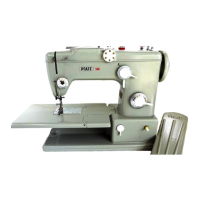Stitch
Formation
1 Hinge stud
2 Take-up lever
li
nk
3 Toke-up crank
4 Motion pattern
of
the toke-up lever
5
Link
toke-up lever
6 Needle
bar
crank
7 Needle
bar
connecting link
8
Needle
bar
connecting stud
9 Needle
bar
10 Needle set screw
11
Needle holder
12 Needle
13 Hook point
14
Hook thread
guard
15 Hook shaft
16 Hook drive shaft
helical
gears
17 Hook drive shaft
18 Rotary hook
19 Arm shaft
20 Driving belt sprocket,
upper
21 Driving belt (Synchroflex)
22
Driving
belt
sprocket, lower
23
Driving belt (cord)
Note:
The needle plate has been omitted in
order
to
give o better view.
The
Take-Up
Lever
Feed
Motion
1 Pressure regulating screw
2 Presser
bar
guide
collar
3 Presser
bar
lifting brocket
4 Presser
bar
5 Thread cutter
6 Sewing foot
7
Center stud
8 Feed motion
diagram
9 Feed
dog
10 Feed
bar
11
Feed lifting shaft crank, front
12
Center stud
13
Roller
14
Feed lifting shaft
15
Center stud
16
Feed rock shaft
17 Feed rock shaft crank
18
Center stud
19
Feed lifting shalt crank,
rear
20
Finger-tip control H
21
Stitch length
dial
G
22
Feed regulator
23
Feed eccentric
24
Arm shaft
25
Feed lifting connection
26
Feed forked connection
The function
of
the
take
-
up
is
to
provide
the
correct
amount
of
thread
required
to
enlarge
the
loop,
and
to
draw
back
the excess
thread
after
the
loop
has
passed
around
the
bobbin
case. As it
approaches
the
highest
point
of
its
stroke,
the
take-up
lever,
ass
isted
by
the
advancing
feed
dog,
pulls
the
stitch
tight
and
at
the
same
time
draws
additional
thread
through
the
upper
te
nsion
for
the
next stitch.
All
Pfaff domestic sewing machines
are
equipped
with
the
long-valued link
take-up
(Fig. 17).
fig.
19 Feed
dog
in
operative position Fig. 20 Sewing forward
and
reverse
The
Feed
Dog
The principal function
of
the
feed
dog
is
to
move
the
material
forward
or
backward
in
accordance
with the stitch length set. Rev
erse
feeding
is
used
to
backtack the
end
of
a seam.
12

